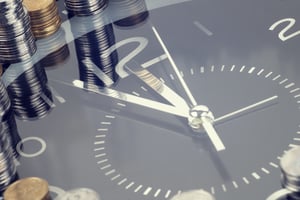
Spot Freight Quote: What to Know & Reasons Why Prices Vary by Provider
January 22, 2021 •Rick LaGore

 At one time or another a company shipping products will have to access the freight spot market to obtain a price and capacity to move one or more of their shipments.
At one time or another a company shipping products will have to access the freight spot market to obtain a price and capacity to move one or more of their shipments.
While the task of obtaining a quote is simple because of the thousands of asset and non-asset freight service providers that make themselves readily available for the call or email request, the task of narrowing down the best solution is often more troublesome because of the variables found in how spot freight quotes are assembled and presented.
On the surface, the two most important points to address in a freight spot quote are price and the service that best fits the requirements for the shipment, but like a glacier, the critical aspects of a spot quote lie beneath the surface.
So, when freight buyers quickly sort their choice on lowest price without looking into the details they can find themselves in a frustrating position where the cost and service is significantly different than what they had budgeted.
With that said, let’s take a look at the components of a freight quote that causes the variability in a spot rate quote.
Components of a Spot Freight Rate Quote
- Capacity
- Transit
- Spot Price Valid Thru
- Linehaul
- Fuel
- Accessorials
- Weight
- Dimensions
- Commodity
- Payment Terms
Freight Capacity
 One would think the actual price is the first component of a freight quote to review, but the reality is capacity. The reason being is if the freight cannot be moved in the time period required, then price is irrelevant.
One would think the actual price is the first component of a freight quote to review, but the reality is capacity. The reason being is if the freight cannot be moved in the time period required, then price is irrelevant.
The availability of freight capacity is typically the biggest reason for significant price disparity in freight quotes between the highest and lowest priced providers in a spot rate.
If there is nothing more you take from this article, know the higher end of a spot rate quote pricing in a tight freight capacity period is most likely being driven by a freight broker that did the upfront work to ensure they can provide the capacity for the quote they submitted.
Now that seems like an odd point to make, so to detail it out the typical process a freight broker goes through to obtain spot rate. The first step in a freight broker’s process is to post the spot load on one or more freight load boards. This is where freight brokers post freight capacity needs (demand) and asset motor carriers post the capacity they have available (supply).
The freight load boards, such as DAT and 123 Loadboard, keep records of the agreed upon price freight brokers and asset motor carriers agree upon. These rates are then compiled and then published. The pricing statistics include: high price, low price and average price seen over the last 12 to 18 months. The rates are then what the freight broker uses to create their published spot freight rate.
Now here is where the issue arises for the shipper, particularly in capacity constrained markets, is the published spot rate sent by the freight broker is not one where actual capacity is available so the freight broker will back peddle and fail to pick-up and deliver on their freight quote. There is also some play for some freight brokers where they will say that their spot price will be available in “X” number of days versus the day in which it may be needed.
While the previously described spot freight quote process is more the “norm” than the exception, there are other freight brokers, such as InTek Freight & Logistics, that take the process a step further to ensure there is capacity on the day the customer desires and for the rate it publishes. Quite often this will make the spot rate appear higher, but the reality is it is the price for the day the capacity is actually available.
So, to close out the section make sure you know if the capacity is actually available for the spot rate quoted.
Transit
The next component of a spot freight quote is transit time.
Various freight modes and the thousands of providers that offer freight capacity have different transits for the freight lanes they serve, so in addition to ensuring the capacity is truly available for the freight quote you receive, one must make sure the transit aligns with requirements.
Like the capacity question, if transit does not meet the delivery requirement the quote is invalid and the larger hurdle of the combination of capacity and transit often makes the spot rate freight quote worthless.
How Long is the Spot Freight Quote Valid
 The spot freight market is one of the best examples of the supply and demand curve taught in economics classes. The higher the demand against low supply drives prices higher, while the inverse of low demand and high supply brings pricing down. The point of equilibrium or where the supply and demand curve cross is where price is settled.
The spot freight market is one of the best examples of the supply and demand curve taught in economics classes. The higher the demand against low supply drives prices higher, while the inverse of low demand and high supply brings pricing down. The point of equilibrium or where the supply and demand curve cross is where price is settled.
Since the supply-demand curve is in constant flux, a spot rate is unlike a contract rate in that it is not a 12 month agreement, but instead a short term commitment that may only be for an hour a day or a short two to three day period.
To avoid surprises on the day of shipment, shippers obtaining the spot quote need to pay close attention to the time period in which the spot rate is valid and be aware that in highly constrained freight markets the spot rate may not be honored at the time of shipment.
Price Components of a Freight Spot Rate
With the three beneath the surface aspects of a spot freight quote being capacity, transit and time period the quote is valid now behind us, let’s take a look at the pricing components of a freight spot rate.
-
Linehaul
-
Fuel
-
Accessorials
The above price components of a freight spot quote are the same as those for a contract rate, although they may be presented to the shipper as an all-in rate or presented into its three components. It is worth noting to ask the question because many freight buyers over the years have thought they were paying an all-in rate, then find out otherwise at the time they receive the final settlement invoice.
A few more points to be aware of for LTL shippers include:
 Know the LTL NMFC classification of your freight and utilize the correct commodity classification because it makes a huge difference in the spot rate and the liability coverage if there is a freight claim on the shipment.
Know the LTL NMFC classification of your freight and utilize the correct commodity classification because it makes a huge difference in the spot rate and the liability coverage if there is a freight claim on the shipment.- Include the pallet weight for LTL shipments to ensure the rate is accurate because the LTL carrier certainly will and adjust their quote to reflect the difference on the freight invoice.
- Make sure the pallet count and dimensions of each pallet are stacked and loaded as presented in the spot freight quote.
Last but not least, make sure special dock, delivery or handling requirements are made known at the time of the freight quote to protect against surprise accessorial charges. Read “Cost of Freight Accessorial Charges: Definitions & Tips on How-to Avoid” if not familiar with potential accessorial charges.
Any adjustments made on the shipping specifications often throw the spot rate out and open your company up for a significantly larger freight invoice than expected.
Payment Terms
The last item to consider in making the spot rates comparable are the payment terms extended. Shippers that are new with a freight broker may find they need to pay upfront with a credit card that brings with it an additional two to three percent processing fee.
Conclusion a Spot Freight Quote
Hopefully this article hit home as to why differences lie in pricing and service between the various freight brokers a company chooses to quote its spot business.
So to close, remember the biggest differences lie with transit, available capacity and the time period the spot rate is valid.
After the previously mentioned items meet your requirements check the cost details to ensure they are comparable, as there are variances in what is and is not considered standard from the various freight brokers.
If you're ready to take the next step, at InTek Freight & Logistics, we can help. Just tell us what you need and we'll discuss how our expertise can help with the unique shipping challenges your business faces. Rather do a bit more research first? View our Freight Guides for comprehensive articles and eBooks on all things freight and logistics.
Get Updates
Featured Articles
Categories
- Freight & Shipping Costs (54)
- Freight Broker (60)
- Freight Forwarder (2)
- Intermodal Transportation (184)
- International & Cross Border Logistics (43)
- Logistics & Supply Chain (420)
- Logistics Service Provider (77)
- LTL (39)
- Managed TMS (49)
- News (39)
- Supply Chain Sustainability (12)
- Transportation Management System (37)
- Truckload (122)
- Warehousing & Distribution (50)



